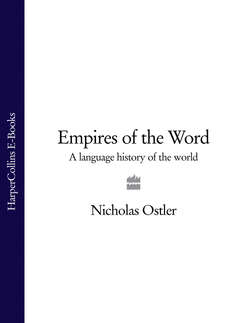Читать книгу Empires of the Word: A Language History of the World - Nicholas Ostler - Страница 29
A stately progress
ОглавлениеArchaeology shows that the Egyptian state was established first in the late fourth millennium BC, in the region surrounding the great salient of the Nile which was later dominated by the city of Wast (known to the Greeks as Thebes), hence in southern or ‘Upper’ Egypt. It is apparent that Egyptian was already the language spoken, since there are legible hieroglyphic captions on labels and pots in the royal cemetery in this area, at Abydos, from the early third millennium. In fact pre-dynastic sites, of this so-called Nagada culture, have been discovered along the whole length of the Nile from Aswan to the delta and including the Faiyum, showing that the whole area of ancient Egypt was already occupied. Since the surrounding desert remained uninhabitable, the kingdom of Egypt was always a ribbon development along the Nile. Traditionally, its history begins when King Menes unified the Upper and Lower lands, and set up his capital at Min Naf∂r (Memphis) in Lower Egypt.*
This achievement remained a matter of legend rather than history, since the king’s name cannot be identified with any of the hieroglyphic evidence, and there is no written evidence of separate kings in the north and south. Nevertheless, there was a tradition of differently shaped and coloured crowns for the two kingdoms, unified formally in the historical crown of the pharaoh† (in a way reminiscent of the composite character of the Union Jack). And the name by which the Egyptians always knew their own country was TaRw∂j, ‘the pair of lands’.
The crowns of Egypt: Lower, Upper, and combined
Thereafter, Egyptian has no history, in that it had achieved its historic domain, the Nile valley from the first cataract to the sea. Although Egyptian power would expand periodically and withdraw again, up the Nile into Nubia and north-eastward over Palestine and Syria, the language did not spread with it. For almost four thousand years its range stayed the same.
Nevertheless, spoken Egyptian did change phonetically and syntactically over this time. The classical language of Egyptian literature was refined and established in the third millennium. Known as ‘Middle Egyptian’, its use was maintained in writing as far as possible until the end of Egypt’s civilisation, above all in formal and ritual texts. But evidently the language gradually changed on the lips of its speakers. Among a host of finer periods, linguists distinguish broadly an earlier era (3000–1300 BC) from a later one (1300 BC-AD 1500). From the middle of the second millennium, it is clear that the spoken language had moved on significantly.
On the simplest level, the sounds of the language change: r and the feminine ending t are lost at the end of words, and (ch in church) and (j in judge) are simplified away, replaced by simple t and d. But there are structural changes too. They are reminiscent of the way in which Italian came to differ from Latin, or Middle English from Anglo-Saxon. In the older period, Egyptian had been highly inflected, with a set of endings for number and gender; it had had no definite or indefinite article (corresponding to English the or a); and the characteristic word order had the verb first in the sentence, followed by subject and then object. In the later period the noun endings tend to be lost, but articles come into play, expressing the distinctions in a different way. The verb system becomes more dependent on auxiliaries, and so less highly inflected. Furthermore, the subject now tends to come first in the sentence (as it does in modern English).
Take a single example, the Egyptian for ‘Hallowed be thy name’. This changed from
The pieces of classical Egyptian are still basically there, but now put together quite differently.
Charmingly, the first glimpse of this later language to appear in the record is the more popular style of writing seen under the religious reformer Pharaoh Akhenaten; this writing reform came along with official portraits that for the first time emphasised a pharaoh’s home life, with his queen Nefertiti and their daughters, around 1330 BC.
Akhenaten with his wife and daughters
Although the state religion and the decorum of official iconography were restored after his reign, the antiquated style of written expression never fully came back. Religious texts (rituals, mythology and hymns) did continue to be written in the classical form of the language; indeed it persisted until the end of hieroglyphic writing in the fourth century AD; but popular literature, school texts and administrative documents show that a different variant of the language was now being used generally.
The language persisted in Egypt as the main medium of daily life for another two thousand years from the time of Akhenaten.
Against this underlying continuity, the main dramatic interest was provided by contact with other languages whose speakers came to live in Egypt. There were four such languages: Libyan, Kushite, Aramaic and Greek.
